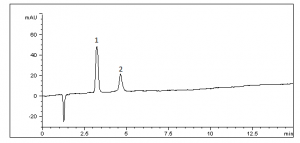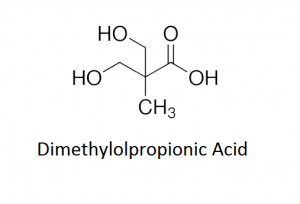Hydrophilic acid retention on the Cogent Diamond Hydride™
Dimethylolpropionic Acid is a unique diol molecule with both hydroxyl and carboxyl functionality and presents several challenges in chromatographic analysis. Traditional reversed phase mode may not be viable due to the high hydrophilicity of this organic acid. Also, by lacking chromophores it can be difficult to detect using conventional HPLC techniques.
By pairing the Cogent Diamond Hydride™ Column with Aqueous Normal Phase this method has proven both detection without the use of derivatization and excellent retention of a very polar compound. If extended retention is desired, a longer dimension column can be employed.

 Peak:
Peak:
1. Dimethylolpropionic acid
2. Sample diluent (Mobile Phase B)
Method Conditions:
Column: Cogent Diamond Hydride™, 4μm, 100Å
Catalog No.: 70000-75P
Dimensions: 4.6 x 75 mm
Mobile Phase:
—A: DI Water/ 10 mM Ammonium Formate (v/v)
—B: 95% Acetonitrile/ 5% DI Water/ 10 mM Ammonium Formate (v/v)
Isocratic: 90%B
Injection Volume: 5μL
Flow Rate: 1.0mL/ minute
Detection: UV @ 215 nm
Sample: 3mg / mL (Diluent: Mobile Phase B)
t0: 0.94 minutes
Note: Dimethylolpropionic acid is often used to provide carboxylate functional group and provide good hydrophilic character for the polyurethane polymer. Dimethylolpropionic acid – based dendrimers may have potent applications as delivery systems for anticancer drugs such as cisplatin and doxorubicin, as well as agents for both boron neutron capture therapy and photodynamic therapy.
Attachment
No. 380 Dimethylpropionic Acid Analyzed with HPLC pdf 98.2 Kb Download File


